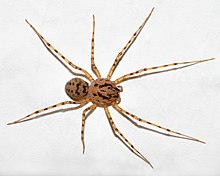Spitting spider
| Spitting spiders Temporal range:
| |
|---|---|

| |
| Scytodes thoracica | |

| |
| Scytodes male, showing pedipalps | |
| Scientific classification | |
| Domain: | Eukaryota |
| Kingdom: | Animalia |
| Phylum: | Arthropoda |
| Subphylum: | Chelicerata |
| Class: | Arachnida |
| Order: | Araneae |
| Infraorder: | Araneomorphae |
| Family: | Scytodidae Blackwall, 1864 |
| Diversity[1] | |
| 4 genera, 252 species | |

| |
Spitting spiders (Scytodidae) is a family of araneomorph spiders first described by John Blackwall in 1864.[2] It contains over 250 species in five genera,[1] of which Scytodes is the best-known.
Description[edit]
Scytodidae spiders are haplogyne, meaning they lack hardened female genitalia. They have six eyes, like most spiders in this group, arranged in three pairs. They possess long legs and a dome-shaped cephalothorax, and are usually yellow or light brown with black spots or marks.[3][4]
Hunting technique[edit]
Scytodidae catch their prey by spitting a fluid that congeals on contact into a venomous and sticky mass. The fluid contains both venom and spider silk in liquid form, though it is produced in venom glands in the chelicerae. The venom-laced silk both immobilizes and envenoms prey such as silverfish. In high-speed footage the spiders can be observed swaying from side to side as they "spit", catching the prey in a criss-crossed "Z" pattern; it is criss-crossed because each of the chelicerae emits half of the pattern. The spider usually strikes from a distance of 10 to 20 millimetres (0.39 to 0.79 in) and the entire attack sequence only lasts 1/700th of a second.[5] After making the capture, the spider typically bites the prey with venomous effect, and wraps it in the normal spider fashion with silk from the spinnerets.[6]
Presocial behaviour[edit]
Some species exhibit presocial behaviour, in which mature spiders live together and assist the young with food.[7]
Genera[edit]

As of January 2024[update], the World Spider Catalog accepts the following genera:[1]
See also[edit]
References[edit]
- ^ a b c "Family: Scytodidae Blackwall, 1864". World Spider Catalog. Natural History Museum Bern. Retrieved 2024-01-12.
- ^ Blackwall, J. (1864). A history of the spiders of Great Britain and Ireland. Ray Society, London. pp. 175–384.
- ^ "SCYTODIDAE Spitting spiders". Arachne.org.au. Retrieved 25 April 2024.
- ^ "Spitting spider". Illinois Department of Natural Resources. Retrieved 25 April 2024.
- ^ Piper, Ross (2007). Extraordinary Animals: An Encyclopedia of Curious and Unusual Animals. Westport, Conn.: Greenwood Press. ISBN 978-0-313-33922-6.
- ^ Gilbert, C.; Rayor, L.S. (1985). "Predatory behavior of spitting spiders (Araneae, Scytodidae) and the evolution of prey wrapping". Journal of Arachnology. 13 (2): 231–241. JSTOR 3705028.
- ^ Miller, Jeremy (2010). "Taxon page for Scytodes socialis Miller, 2006". Archived from the original on 2012-03-31.
External links[edit]
- Arachnology Home Pages: Araneae
- Info about Spitting spider Scytodes thoracica
- Platnick, N.I. 2003. World Spider Catalog
